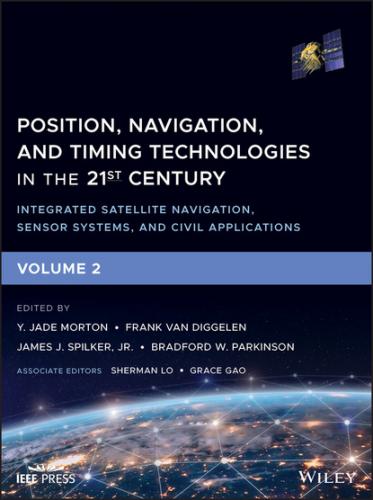10 Glossary, Definitions, and Notation Conventions Glossary
11 Index
List of Tables
1 Chapter 35Table 35.1 Sensors covered in Volume 2
2 Chapter 36Table 36.1 Simulation parametersTable 36.2 Summary of filter classes
3 Chapter 38Table 38.1 GPS versus cellular CDMA and LTE comparisonTable 38.2 Typicalh0 and h−2 values for different OCXOs [36]Table 38.3 FIR of the pulse shaping filter used in cdma2000 [50]Table 38.4 LTE system bandwidths and number of subcarriersTable 38.5 Test dates, locations, and carrier frequenciesTable 38.6 DOP values forM GPS SVs + N cellular towersTable 38.7 UAV’s RMSEs and final errors after 50 s of GPS cutoff
4 Chapter 39Table 39.1 Comparison between GPS L1 C/A code and MBS 2 MHz signalTable 39.2 Telecom networks phase/frequency sync requirements
5 Chapter 40Table 40.1 Geometry from a receiver at (0, 0, 0) to DTV transmitters
6 Chapter 41Table 41.1 Phase code for master and secondary (“+” indicates 0 radians phase...Table 41.2 Electrical characteristics of well‐known Loran antennasTable 41.3 Loran‐C Performance Requirements [89]Table 41.4 eLoran aviation and maritime performance requirements
7 Chapter 42Table 42.1 Parameters for different INS Grades. All INS Grades use a time con...
8 Chapter 43aTable 43.1 Constellation comparison [4]Table 43.2 Comparison of LEO and MEO systems for navigationTable 43.3 Results of the Iridium‐based STL indoor testing in comparison to G...Table 43.4 Comparison of GPS and OneWeb user position accuracy from a global ...Table 43.5 Comparison of GPS atomic clocks and chip‐scale atomic clock perfor...Table 43.6 Comparison of SIS URE weight factors for the statistical contribut...Table 43.7 Comparison of root‐mean‐square orbit radial (R), along‐track (A), ...Table 43.8 Comparison of orbit determination methods
9 Chapter 43bTable 43.9 Existing and future LEO constellations: number of satellite and tr...Table 43.10 Starlink orbital configurationTable 43.11 RMSEs (in meters) from 100 Monte Carlo runs for varying number of...Table 43.12 Simulation results with Globalstar, Orbcomm, and Iridium LEO sate...Table 43.13 Simulation results with Starlink LEO satellites for a UAV navigat...Table
